|
When
you arrive at Portsmouth Historic Dockyard the stunning
sleek black lines of Britain's first iron-hulled
(4") armoured battleship, take your breath away.
The
pride of Queen Victoria, Warrior revolutionised
warship construction. Powered by steam and sail, she was
the largest and fastest ship of her day. Her most
radical innovation was her citadel - an armoured box
housing her guns.
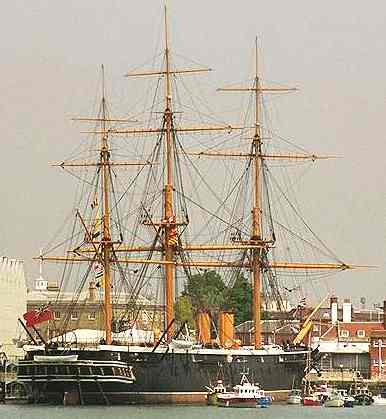
HMS Warrior - Portsmouth
historic dockyard
HMS Warrior was the name ship of her class of two armoured frigates built for the Royal Navy in 1859–61. She and her sister ship HMS Black Prince were the first armour-plated, iron-hulled warships; they were built in response to the first ironclad ocean-going warship, the wooden-hulled French ironclad Gloire, launched in 1859. Rapid advances in naval technology left Warrior and her sister obsolete within a short time, however, and she spent more time in reserve and training roles than in first-line service.
Warrior spent her active career with the Channel Fleet and was hulked in 1883. She served as a storeship and depot ship before she was assigned to Royal Navy's torpedo training school in 1904. The ship was converted into a floating oil jetty in 1927 and remained in that role until 1979 when restoration began. Listed as part of the National Historic Fleet, she is now a museum ship in Portsmouth, England.
Warrior
began active service most inauspiciously. She froze to
the slipway when she was launched on December 29th 1860
during the coldest winter for 50 years. Frozen snow
covered the dockyard and Thames braziers blazed down the
ship's sides but when Sir John Pakington, First Lord of
the Admiralty, came to do the honours, she refused to
budge.
Extra
tugs and hydraulic rams pulled her while hundreds of men
ran from side to side on her upper deck, trying to rock
her free. After 20 minutes, she finally gave way. Sir
John smashed a bottle of wine over her bow with the
words "God speed the Warrior"
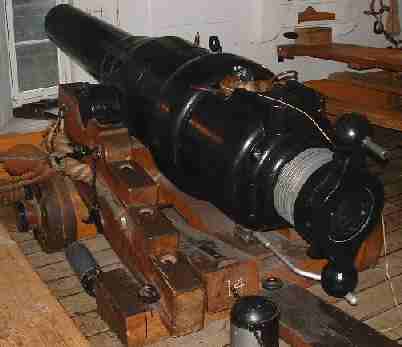
Warrior breach loading canon
Warrior
was obsolete in less than a decade. She was relegated to the
Reserve Fleet ranks and in 1883, withdrawn from sea
service. She was now little more than a floating hulk,
although still officially classed an armoured cruiser.
Her
masts and guns were stripped when she was used as a
depot ship for two years. Her name became Vernon III
in 1904, when she joined Portsmouth-based HMS Vernon,
the Navy's torpedo training school. Her role was
supplying steam and electricity to neighbouring hulks. A
year later, another armoured cruiser called Warrior
was launched.
The
Hon Arthur Cochrane, son of the Earl of Dundonald,
became her captain after her commission on August 1st
1861. The ship underwent minor modifications after a sea
trial. In June 1862, she started active service in the
Channel Squadron, patrolling coastal waters and sailing
to Lisbon and Gibraltar. Crowds
of people turned out to see the new battleship as she visited British ports.
But, she never fired a shot in anger. Her strength was her ability to
keep the peace by her awesome presence.
Foreign
navies soon imitated her technical features, and armour-plated
look-alikes with even greater firepower rolled down
dockyard slipways. Engine designs improved steadily,
with coaling stations springing up in ports all over the
world.
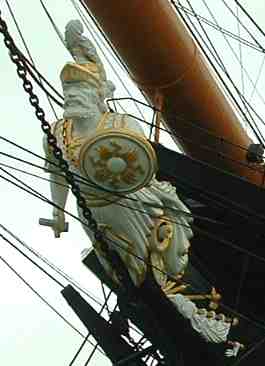
Warrior's figurehead
Nobody
wanted the old battleship when she went up for sale in
1924. Five years on, she inherited the name Oil
Fuel
Hulk C77 when starting life as a shipkeeper's home
and floating oil jetty at Pembroke Dock in Wales.
Some
5,000 ships refuelled alongside her in her 50 years at
Pembroke. However, the Royal Navy kept her in reasonable
condition with occasional maintenance trips into dry
dock keping her hull intact. Warrior was the only
example of the 45 ironhulls built between 1861 and 1877
to survive.
DESIGN
The Warrior-class ships have been described as revolutionary, but in truth they were more evolutionary as everything except their wrought-iron armour had been used in ocean-going ships for years. The naval architect and historian David K. Brown has written, "What made [Warrior] truly novel was the way in which these individual aspects were blended together, making her the biggest and most powerful warship in the world." The ships were built in response to Gloire, which started an invasion scare in Britain, but they had a very different concept of operation to the French ship, which was meant as a replacement for
wooden ships of the line. They were designed by Chief Constructor of the Navy Isaac Watts as 40-gun armoured frigates. The Warrior-class ships were not intended to stand in the line of battle, as the Admiralty was uncertain about their ability to withstand concentrated fire from wooden two and three-deck ships of the line. But, unlike Gloire, they were planned to be fast enough to force battle on a fleeing enemy and to control the range at which a battle was fought to their own advantage.
HMS Warrior was 380 feet 2 inches (115.9 m) long between perpendiculars and 420 feet (128.0 m) long overall. She had a beam of 58 feet 4 inches (17.8 m) and a draught of 26 feet 9 inches (8.2 m). The ship displaced 9,137 long tons (9,284 t) and had a tonnage of 6109 tons burthen. The hull was subdivided by watertight transverse bulkheads into 92 compartments and had a double bottom underneath the engine and boiler rooms.
PROPULSION
The Warrior-class ships had a single two-cylinder trunk steam engine made by John Penn and Sons driving a single 24-foot-6-inch (7.5 m)
propeller. Ten rectangular
boilers provided steam to the engine at a working pressure of 20 psi (138 kPa; 1 kgf/cm2). The engine produced a total of 5,772 indicated horsepower (4,304 kW) during Warrior's sea trials on 1 April 1868 and the ship had a speed of 14.079 knots (26.074 km/h; 16.202 mph) under steam alone.[9] The ship carried 800–850 long tons (810–860 t) of coal, enough to steam 2,100 nautical miles (3,900 km; 2,400 mi) at 11 knots (20 km/h; 13 mph).
The ironclads were ship rigged and had a sail area of 48,400 square feet (4,497 m2). Warrior reached 13 knots (24 km/h; 15 mph) under sail, 2
knots (3.7 km/h; 2.3 mph) faster than her sister ship Black Prince. Her propeller was designed to be hoisted up into the stern of the ship to reduce drag while under sail; the largest hoisting propeller ever made, it required 600 men to raise it into the stern. To further reduce drag, her funnel was
telescopic and could be lowered.
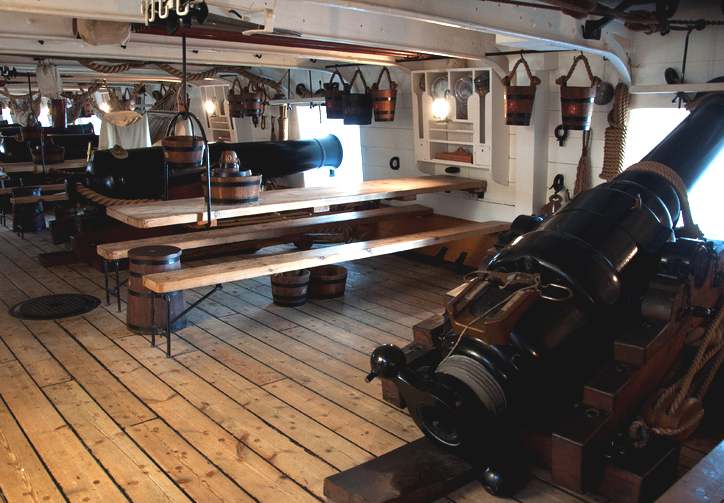
ARMAMENT
The armament of the Warrior-class ships was intended to be 40 smoothbore, muzzle-loading 68-pounder guns, 19 on each side on the main deck and one each fore and aft as chase guns on the upper deck. This was modified during construction to ten Armstrong 7-inch, 110-pounder rifled breech-loading guns (RBL), twenty-six 68-pounders, and four RBL Armstrong 40-pounder guns. It had been planned to replace all the 68-pounders with the 7-inch Armstrong guns, but poor results in testing brought a halt to this plan.
The 7.9-inch (201 mm) solid shot of the 68-pounder gun weighed approximately 68 pounds (30.8 kg) while the gun itself weighed 10,640 pounds (4,826.2 kg). The gun had a muzzle velocity of 1,579 ft/s (481 m/s) and had a range of 3,200 yards (2,900 m) at an elevation of 12°. The 7-inch (178 mm) shell of the 110-pounder Armstrong breech-loader weighed 107–110 pounds (48.5–49.9 kg). It had a muzzle velocity of 1,150 ft/s (350 m/s) and, at an elevation of 11.25°, a maximum range of 4,000 yards (3,700 m). The shell of the 40-pounder breech-loading gun was 4.75 inches (121 mm) in diameter and weighed 40 pounds (18.1 kg). The gun had a maximum range of 3,800 yards (3,500 m). All of the guns could fire both solid shot and explosive shells.
The ship also carried two RBL Armstrong 20-pounders and one RBL Armstrong 12-pounder, largely intended for use in the ship's boats or for use as field guns, although they were mounted for use on board. Finally, a 6-pounder brass cannon was carried for practice use.
The 40-pounder Armstrong guns were replaced with a better design of the same calibre in 1863. Warrior's original armament was replaced during her 1867–68 refit with twenty-four 7-inch and four 8-inch (203 mm) rifled muzzle-loading guns. The ship also received four 20-pounder breech-loading guns for use as saluting guns.
The shell of the 15-calibre 8-inch gun weighed 175 pounds (79.4 kg) while the gun itself weighed 9 long tons (9.1 t). It had a muzzle velocity of 1,410 ft/s (430 m/s) and was credited with the ability to penetrate a 9.6 inches (244 mm) of wrought iron armour at the muzzle. The 16-calibre 7-inch gun weighed 6.5 long tons (6.6 t) and fired a 112-pound (50.8 kg) shell that was able penetrate 7.7-inch (196 mm) of
armour.
ARMOUR
Warrior's armour consisted 4.5 inches (114 mm) of iron backed by 18 inches (457 mm) of teak. The iron armour was made up of plates 3 feet by 12 feet that interlocked via the tongue and groove method. It was bolted through the teak to the iron hull. The teak consisted of two 9-inch-thick (229 mm) layers laid at right angles to each other. The teak served to strengthen the armour by damping the shock waves caused by the impact of shells that would otherwise serve to break the bolts that connected the armour to the hull. Based on tests at Shoeburyness in October of 1861 when the Warrior was launched, it "was practically invulnerable to the ordnance at the time in use".
The armour covered the middle 213 feet (64.9 m) of the ship and extended 16 feet (4.9 m) above the waterline and 6 feet (1.8 m) below it. 4.5-inch transverse bulkheads protected the guns on the main deck from raking fire. The ends of the ship were left entirely unprotected, which meant that the
steering gear was very vulnerable. Another weakness was that the armour became more brittle at lower temperatures and thus less resistant to impacts.
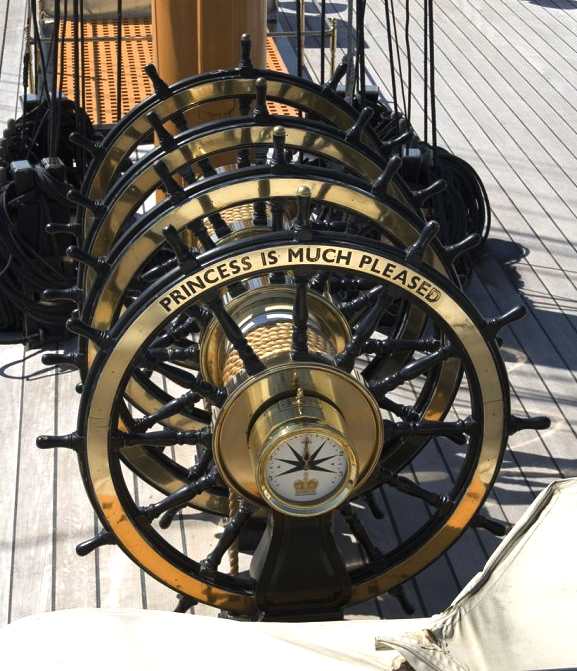
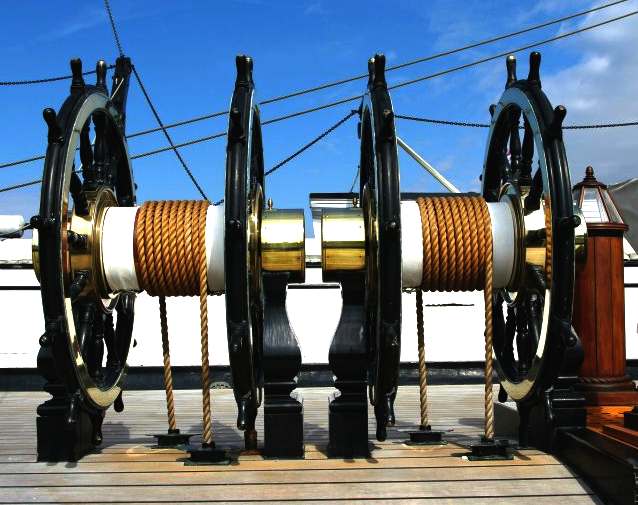
SERVICE CAREER
Warrior was ordered on 11 May 1859 from Thames Ironworks and Shipbuilding Co. in Blackwall, London. The ship was laid down on 25 May 1859, launched on 29 December 1860 and completed on 24 October 1861 for the price of £377,292. She was commissioned earlier, in August 1861, to conduct her sea trials. Between March and June 1862, defects exposed during her trials were rectified, and damage received during the trials repaired. Changes included the fitting of a lighter bowsprit and a shorter jib boom, along with the provision of extra heads amidships.
The ship was assigned to the Channel Squadron under the command of Captain Arthur Cochrane. In March 1863, Warrior escorted the royal yacht bringing Princess Alexandra of
Denmark to Britain to marry the Prince of Wales. In mid-1863 the Channel Fleet toured the ports of Great Britain, where the ship was the centre of attention.
Warrior began a refit in November 1864. She was briefly commissioned with the intention of becoming guardship at Queenstown, Ireland, and appeared in the 1867 Fleet Review. This commission was cancelled after 24 days, and on 25 July 1867 she was again recommissioned under Captain Henry Boys. After working up at Spithead, she sailed to join the Channel Squadron on 24 September. In 1865 she was deployed to Osborne Bay to guard Queen Victoria at Osborne House. This was not merely an honorary guard, since this was the year of the Fenian Rising, and there was intelligence suggesting that the
Queen might be in danger from Irish nationalists. At some point during the time Warrior was performing this duty, the ship received an informal visit from the Queen. The ship was part of a squadron that escorted the royal
yacht HMY Victoria and Albert II to Dublin in April 1868 for an official visit by the Prince of Wales, the future King Edward VII. In August, cruising to Scotland, Warrior collided with HMS Royal Oak, losing her figurehead and jib boom and seriously damaging Royal Oak's cutter.
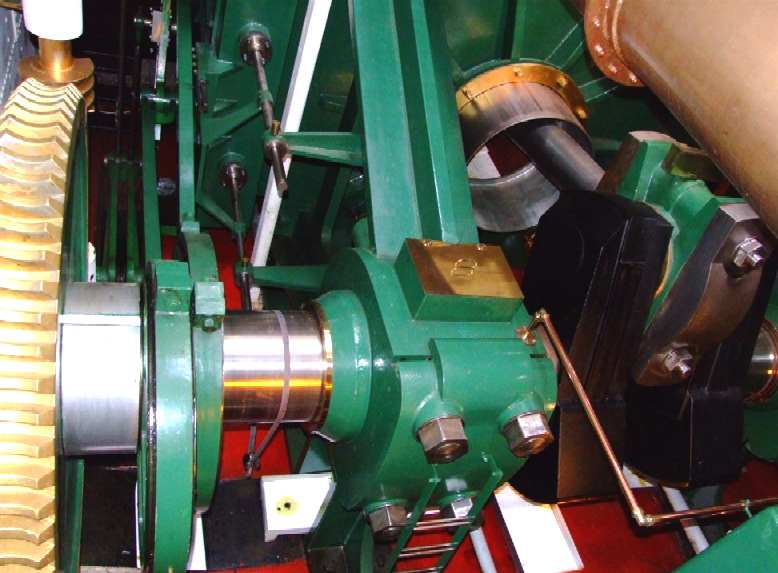
From 4 to 28 July 1868, Warrior, together with Black Prince and the wooden paddle frigate HMS Terrible, was employed to tow the specially built floating dry dock Bermuda across the Atlantic from Madeira to Ireland Island,
Bermuda. After a refit to have her bottom cleaned and the figurehead lost in the collision with Royal Oak replaced, Warrior rejoined the Channel Squadron. While returning from a joint cruise with the Mediterranean Fleet, the ship was present when HMS Captain was lost during a severe storm on 7 September 1870. Further cruises followed, including trips to Madeira and
Gibraltar. While departing Gibraltar, Warrior was following HMS Agincourt when the latter ship grounded on Pearl Rock, and narrowly missed colliding with her.
In September 1871, Warrior began a refit that lasted until 1875, including a new poop deck and steam capstan, a shorter bowsprit, and replacement boilers. In April 1875, the ship was recommissioned, having now been relegated to the First Reserve, where she served as a guardship at Portland. In this role, she went on yearly summer cruises to various ports. In 1878 she was mobilised in reaction to concerns that Russia might be about to attack Constantinople, but the attack did not materialise, and Warrior cruised to Bantry Bay. In April 1881 she was transferred to the Clyde District, where she served as guardship until 31 May 1883.
Warrior was then used as a storage hulk and, from 1902 to 1904, as a depot ship for a flotilla of destroyers. Her name was changed to HMS Vernon III in March 1904, a month after she joined Portsmouth-based Vernon, the Royal Navy's torpedo training school. Her role was supplying steam and electricity to the neighbouring hulks that made up Vernon. In October 1923, the school was transferred to a newly built shore installation, rendering Warrior and her companion hulks redundant; the
Royal Navy put her up for sale in 1924.
The mass scrapping of obsolete ships after World War I had caused a downturn in demand for scrap iron by the time the Navy decided to sell off Warrior. There was no commercial interest in the old ship, and she remained at Portsmouth for another five years, although she was modified into a mooring jetty in 1927. The hulk was towed to her new home, Pembroke Dock, Wales, in March 1929. Upon arrival, she served as a floating oil jetty known from 1942 as Oil Fuel Hulk C77. For the next fifty years, the ship lay just offshore from an oil depot at Llanion Cove, occasionally being towed to a nearby dry dock for maintenance work and additionally serving as a base ship for coastal
minesweepers in
World War II. She refuelled some 5,000 ships during her service at Llanion Cove.
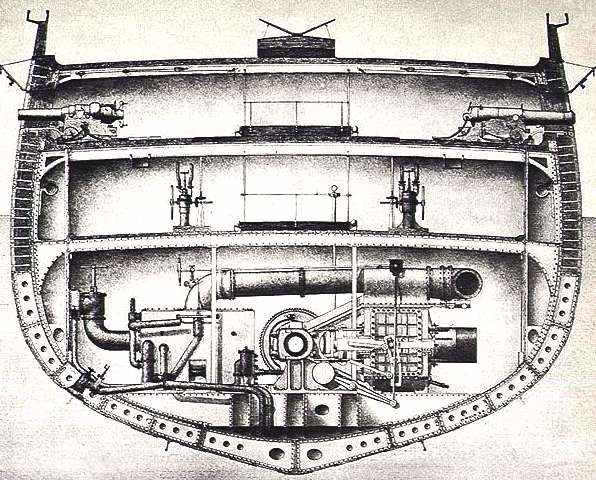
RESTORATION
Warrior was saved from being scrapped by the efforts of the Maritime Trust, led by John Smith MP. As the world's first iron-hulled armoured warship, she was recognised as one of the Royal Navy's most historically important warships. In 1968 the Duke of Edinburgh chaired a meeting that considered the possibility of rescuing and restoring Warrior, and a year later the Maritime Trust was established with a view to saving the decrepit ironclad and other historic ships. Throughout the 1970s, the Trust carried out negotiations and feasibility studies regarding Warrior, and finally obtained control of the
ship in August 1979. Ownership was transferred to the Ship's Preservation Trust in 1983, which became the Warrior Preservation Trust in 1985.
Restoration of Warrior for use as a museum ship began in August 1979, when she began her 800-mile (1,300 km) journey to her temporary home in the Coal Dock at Hartlepool, where the £8 million restoration project was carried out, largely funded by the Manifold Trust. The ship arrived in Hartlepool on 2 September 1979. Over the next eight years, Warrior's decks, interior compartments, engines, woodwork and fittings were restored or recreated, her masts, rigging and funnels were recreated, and a new figurehead was carved using photographs of the original (destroyed in the 1960s) as a guide.
The restored ironclad was renamed HMS Warrior (1860) to avoid confusion with the Northwood Headquarters, commissioned as HMS Warrior, which was at the time the operational headquarters of the Royal Navy.
MUSEUM SHIP
Preparations for Warrior's arrival in Portsmouth began in 1985, when a new berth beside Portsmouth Harbour railway station was dredged and a new hard was constructed at an estimated cost of £1.5 million. Warrior left Hartlepool on 12 June 1987 and was towed 390 miles to the Solent where she arrived on arrived the 16th June. That afternoon she was towed into Portsmouth Harbour and welcomed by thousands of people lining the town walls and shore, and over 90
boats and ships. She officially opened as a museum on 27th July 1987.
Warrior is part of the Portsmouth Historic Dockyard complex, which is also the home of HMS Victory and the Mary Rose. In 1995 she received just over 280,000 visitors and the whole dockyard receives between 400,000 and 500,000 visitors annually.
Although part of the dockyard, Warrior is still managed by the Warrior Preservation Trust and as well as being open daily as a museum, she is a venue for
weddings and functions. Income generated from these events funds the Trust's work.
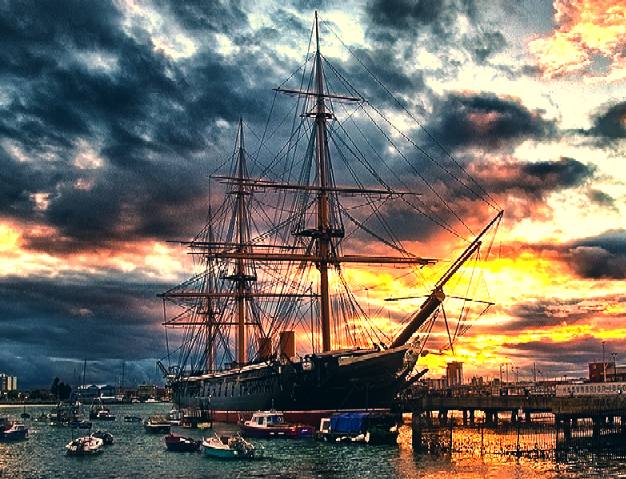

SHIP
LINKS
SS
Alabama
HMS
Belfast
Britain's last WW2 Crusier
RY
Britannia
The Royal Yacht
HMS
Cavalier
A WW2 Destroyer
USS
Constitution
Cutty
Sark
Last of the Tea Clippers
RRS
Discovery
Antartic Research Ship
S.S.
Great Britain
Brunel's Great Ship
HMS
Trincomalee 1817
Britain's oldest warship afloat
The
Vasa
17th Century Swedish Warship
MUSEUM
LINKS
LINKS:
http://www.navy.mil/navydata/cno/n87/usw/issue_29/predator.html
http://www.hightech-edge.com/proteus-submarine-unmanned-underwater-vehicle/10756/

The
Solar Navigator - SWASSH (Small Waterplane Area Stabilized Single Hull)
test model 2012
The
latest Solarnavigator is a robot ship designed to be capable of an autonomous
world navigation set for an attempt in
2015 if all goes according to schedule. The platform is also ideal for
persistent monitoring 365 days year 24/7 - with data streamed back to
your command HQ via satellite.
|










